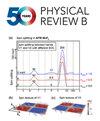Bulk band structure of RuO2 measured with soft x-ray angle-resolved photoemission spectroscopy
IF 3.7
2区 物理与天体物理
Q1 Physics and Astronomy
引用次数: 0
Abstract
Altermagnetism exhibits unique physical properties such as spin-momentum locking, anomalous Hall effect, nontrivial topological phase, and giant magnetoresistance. Among all the predicted candidates, several room-temperature altermagnets are suggested to host significant potential applications. RuO2 has been proposed as the most promising candidate. However, recently, there is intense debate about whether软x射线角分辨光谱学测量的氧化钌体带结构
电磁学具有独特的物理性质,如自旋动量锁定、反常霍尔效应、非平凡拓扑相和巨磁阻。在所有预测的候选材料中,几种室温交替磁体被认为具有重要的潜在应用价值。RuO2被认为是最有希望的候选者。然而,近年来,关于RuO2是否具有磁有序的争论非常激烈。通过几种不同技术的实验,证实了共线磁序和自旋分裂诱导效应。然而,最近的μ子自旋共振(μSR)结果显示,RuO2中没有磁序,这表明时间反转对称性没有被打破。高分辨率体带结构的直接观测是迄今为止缺乏的,但对于研究RuO2的电子结构至关重要。在本研究中,我们利用软x射线角度分辨光发射光谱,系统地直接实验观察了RuO2的体带结构。2025年由美国物理学会出版
本文章由计算机程序翻译,如有差异,请以英文原文为准。
求助全文
约1分钟内获得全文
求助全文
来源期刊

Physical Review B
物理-物理:凝聚态物理
CiteScore
6.70
自引率
32.40%
发文量
0
审稿时长
3.0 months
期刊介绍:
Physical Review B (PRB) is the world’s largest dedicated physics journal, publishing approximately 100 new, high-quality papers each week. The most highly cited journal in condensed matter physics, PRB provides outstanding depth and breadth of coverage, combined with unrivaled context and background for ongoing research by scientists worldwide.
PRB covers the full range of condensed matter, materials physics, and related subfields, including:
-Structure and phase transitions
-Ferroelectrics and multiferroics
-Disordered systems and alloys
-Magnetism
-Superconductivity
-Electronic structure, photonics, and metamaterials
-Semiconductors and mesoscopic systems
-Surfaces, nanoscience, and two-dimensional materials
-Topological states of matter
 求助内容:
求助内容: 应助结果提醒方式:
应助结果提醒方式:


